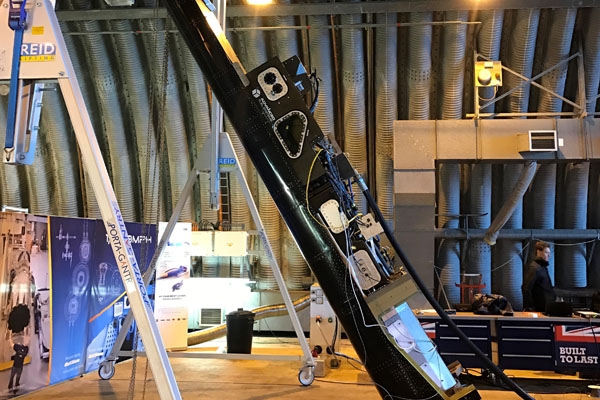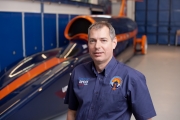
- Key milestone in the development of BLOODHOUND SSC
- Testing and development work recommences at the Aerohub, Newquay
The BLOODHOUND Project engineers today successfully completed the testing and validation of the car’s jet fuel system at the Aerohub at Cornwall Airport, Newquay.
The BLOODHOUND Supersonic Car combines a hybrid rocket motor with a Rolls-Royce EJ200 jet engine to produce 47,500lbs of thrust – equivalent to 135,000 thrust horse power. Today’s tests were to ensure that the car’s unique fuel system will reliably deliver 500 litres of aviation fuel to the jet under sustained loads of up to +2g acceleration and -3g deceleration.
 To simulate these loads, the rear lower chassis was elevated to 60° using a Reid Lifting Porta Gantry. BLOODHOUND engineers then carried out a series of experiments to ensure the fuel can be drawn out of the tank and fed into the jet engine at the required flow rates.
To simulate these loads, the rear lower chassis was elevated to 60° using a Reid Lifting Porta Gantry. BLOODHOUND engineers then carried out a series of experiments to ensure the fuel can be drawn out of the tank and fed into the jet engine at the required flow rates.
Balancing the flow rates from each tank has presented a particular engineering challenges as the left and right hand sides of the car must remain balanced to maintain stability.
The fuel tanks take the form of three carbon fibre boxes which intricately fit into a confined space behind the cockpit, underneath the jet air intake and around the V8 rocket pump motor. Manufactured by URT, using woven material from Sigmatex which was impregnated with resin by SHD, the cases have 15mm thick walls and contain ballistic nylon bladders, pumps from a Tornado aircraft and connectors from TE Connectivity. The system was designed with the expert assistance of Jonathan Tubb from Advanced Fuel Systems, who assembled the components and supported the BLOODHOUND Technicians on the installation into the chassis.
 To prevent 500kg of fuel slamming against the carbon fibre tank wall under acceleration, baffles have been built into the structure. One-way valves are fitted to ensure fuel flows in the desired direction.
To prevent 500kg of fuel slamming against the carbon fibre tank wall under acceleration, baffles have been built into the structure. One-way valves are fitted to ensure fuel flows in the desired direction.
The 500 litres of jet fuel weigh 400kg: at peak acceleration of 2g this will exert a load of 800kg on the tank walls and at peak deceleration (3g) this will be 1,200kg, the weight of a small family car. The main tank is split into two sections by a baffle, which
spreads these loads.
BLOODHOUND’s system engineers used Diamond Point computer hardware and an array of Gem Sensors to closely monitor the tests and validate the results.
The test marks a major milestone in the build of the BLOODHOUND Supersonic Car, which will see development work carried out at the Aerohub at Cornwall Airport Newquay throughout 2017 as the Team prepares to challenge for an 800mph record. Support from the Aerohub Enterprise Zone, Cornwall Council and Local Enterprise Partnership enabled the Project to test an early prototype rocket in a Hardened Air Shelter (HAS) back in 2012 and the same building was used for these crucial tests.
BLOODHOUND’s Chief Engineer Mark Chapman said “This test marks a milestone in the development of the Supersonic Car. It’s the culmination of many months of engineering, detailed planning and high tech manufacturing, all made possible with the support of world class sponsors, including Advanced Fuel Systems, Rolls-Royce and Flightline Support, who provided the fuel bowser.” He continued, “The Team are also indebted to the Aerohub, Newquay and Cornwall Development Company for hosting the tests and the forthcoming development campaign.”













